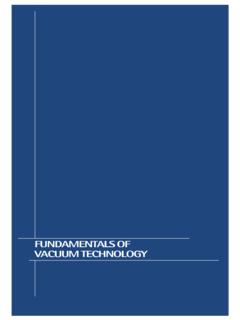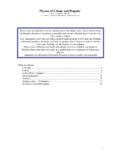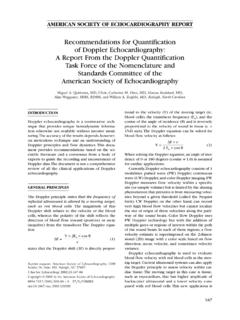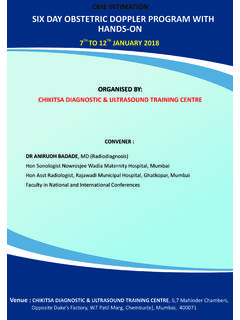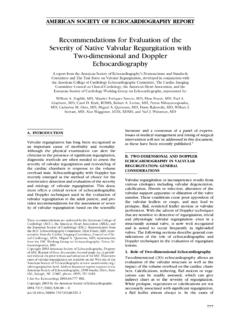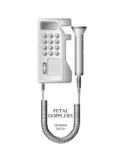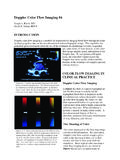Transcription of The Doppler Effect of a Sound Source Moving in a Circle
1 THE PHYSICS TEACHER Vol. 41, February 2003 DOI: I first heard about an experiment thatillustrates the Doppler Effect by twirling abuzzer around one s head,1I was in-trigued and wondered if this experiment would workor not. In fact, it works because you usually do notplace both ears exactly in the center of the Circle ; thiswould be very difficult indeed. When the sourcemoves in a Circle , the distance from the center is al-ways constant, and there is no approaching or reced-ing velocity at all. Holding a microphone in the samehand that holds the string that is attached to thebuzzer easily shows this simple fact. No Doppler ef-fect is observed. Although several qualitative demon-strations and experiments of the Doppler Effect havebeen published,1,2only a very few quantitative experi-ments are found in the devised anew method to quantify the Doppler Effect , describedin a previous article,4we thought it would be a goodphysics and geometry exercise to calculate and mea-sure the frequency variations when the microphone isplaced on the circular path of the SetupIn order to do that, the apparatus shown in Fig.
2 1was set up. A motor controlled by a variable dc powersupply spins a long aluminum bar. On this bara counterweight and a buzzer connected to a 9-V bat-tery are bar is set to spin at a constant angular speedand the Sound is recorded. The Sound of the buzzer atrest must also be recorded as a reference. The Sound iscaptured as a .wav file using a microphone connectedto the line in computer s soundboard, available inmost .wav file is then analyzed in a spectrogramsoftware program. The software used in our study isavailable on the displays the audio signal as afrequency-versus-time plot with signal amplitude atThe Doppler Effect of aSound Source Moving ina CircleMarcelo M. F. Saba,Instituto Nacional de Pesquisas Espaciais, INPE, BrazilRafael Ant nio da S.
3 Rosa,Clube de Ci ncias Quark, Instituto Tecnol gico de Aeron utica, BrazilFig. 1. Schematic of the experimental setup: (a) sideview, (b) top PHYSICS TEACHER Vol. 41, February 2003each frequency represented by intensity (or color). Al-so, a continuous readout of time (ms), frequency(Hz), and signal level (dB) at the position of themouse pointer (cursor) allows an easy sampling of thefrequencies with maximum signal 2 shows a typical display given by the spec-trogram software. The recorded frequency of thebuzzer increases to its maximum value when it ap-proaches the microphone (maximum approachingspeed). And it is abruptly decreased to its minimumjust after the buzzer passes over the microphone (max-imum receding speed). When the buzzer is locatedopposite to the microphone, there is no movement to-wards or away from it.
4 Therefore, the recorded fre-quency (f) is the same as that produced by the buzzerat rest (f0).TheoryLet the receding/approaching velocity be VD. Itwill be positive if the buzzer is receding and negative ifit is approaching the microphone. If the observer (mi-crophone) is at rest, the relationship between fand f0will be given by the well-known Doppler Effect equa-tion:f= f0 vs+vVsD ,(1)where vsis the Sound order to find VDas a function of time, one needsto make some geometrical considerations based onFig. Vcos ,with Vthe tangential velocity of the buzzer and the angle between Vand VD. If Tis the period ofrotation of the buzzer and R the radius of the Circle ,thenV= 2 TR ,which givesVD= 2 RTcos .(2)Observing the angles in Fig. 3 we find that + 2 = and + = /2.
5 Solving for we get = a constant V, = 2 t/T, which makes = substitution into Eq. (2) yields:VD= 2 TR cos Tt .(3)Substituting this expression into Eq. (1) gives thefinal equation:f= f0 .(4)ResultsWe can determine T dividing the time of 10 revo-lutions by 10 or looking directly at the spectrogram tofind the time between two consecutive peak frequen-cies in Fig. 2. From the spectrogram of the buzzer atrest, we can find tfrom 0 to Tfor two revolutions, we su-vs vs+ 2 TR cos Tt Fig. 2. Spectrogram of the recordedsound of the Moving Source (below)and signal intensity (above).VVD Fig. 3. Schematic geometry to calculate theapproaching and receding PHYSICS TEACHER Vol. 41, February 200391perimposed the theoretical Eq. (4) on the experimen-tal data taken from the spectrogram (see Fig.)
6 4). Thesolid line in the figure is the theoretical curve Eq. (4).The data points are represented by small squares andthe error bars are also shown. Experimental results arein good agreement with theoretical experiment presented here provides nice addi-tions to the standard study of the Doppler Effect in astraight-line found that, apart fromhaving a good chance of applying more geometry andtrigonometry to physics, this relatively simple experi-ment gives a deeper understanding of the Doppler ef-fect. This was very clearly observed when we saw thatthe students could tell the position of the buzzer in eachmoment of the frequency-versus-time graph (Fig. 4).AcknowledgmentsThe authors would like to thank the students Jo oGabriel de Magalh es (Col gio Anglo/CassianoRicardo), V tor Jos Ferreira da N brega, andRicardo Motoyama (Col gio Poliedro) for their helpwith this P.
7 Doherty and D. Rathjen,The Exploratorium ScienceSnackbook (San Francisco, 1991), p. V. Mallete, Doppler Effect using a high frequencybuzzer, Phys. Teach. 10, 283 (May 1972).3. R. Gagne, Determining the speed of Sound using theDoppler Effect , Phys. ,126 (Feb. 1996).4. Saba and Rosa, A quantitative demon-stration of the Doppler Effect , Phys. Teach. 39,431 433 (Oct. 2001).5. GRAM software, by R. S. Horne, available at: links to other commercial and freeware programsfor audio spectrum analysis at codes: , , Saba received his in space science fromthe National Institute for Space Research in Brazil. Hisresearch interest is in the area of lightning physics andphysics education. He coordinates the Quark ScienceClub ( ) where high school andundergraduate students have lots of fun developing newhands-on physics research projects.
8 Instituto Nacional dePesquisas Espaciais, INPE, Brazil; Ant nio da S. Rosais currently an undergraduatestudent at Instituto Tecnol gico de Aeron utica. He hasbeen advising high school students at Quark ScienceClub since 1999, providing young people the opportunityto embrace the wonder of physics and rewards throughscientific competitions. Clube de Ci ncias Quark, InstitutoTecnol gico de Aeron utica, (Hz)Time (ms)BuzzerapproachingBuzzerreceding47000 1002003004005006007008004800490050005100 5200spectrogramtheoryf0 Fig. 4. Calculated and recorded frequency variations.
